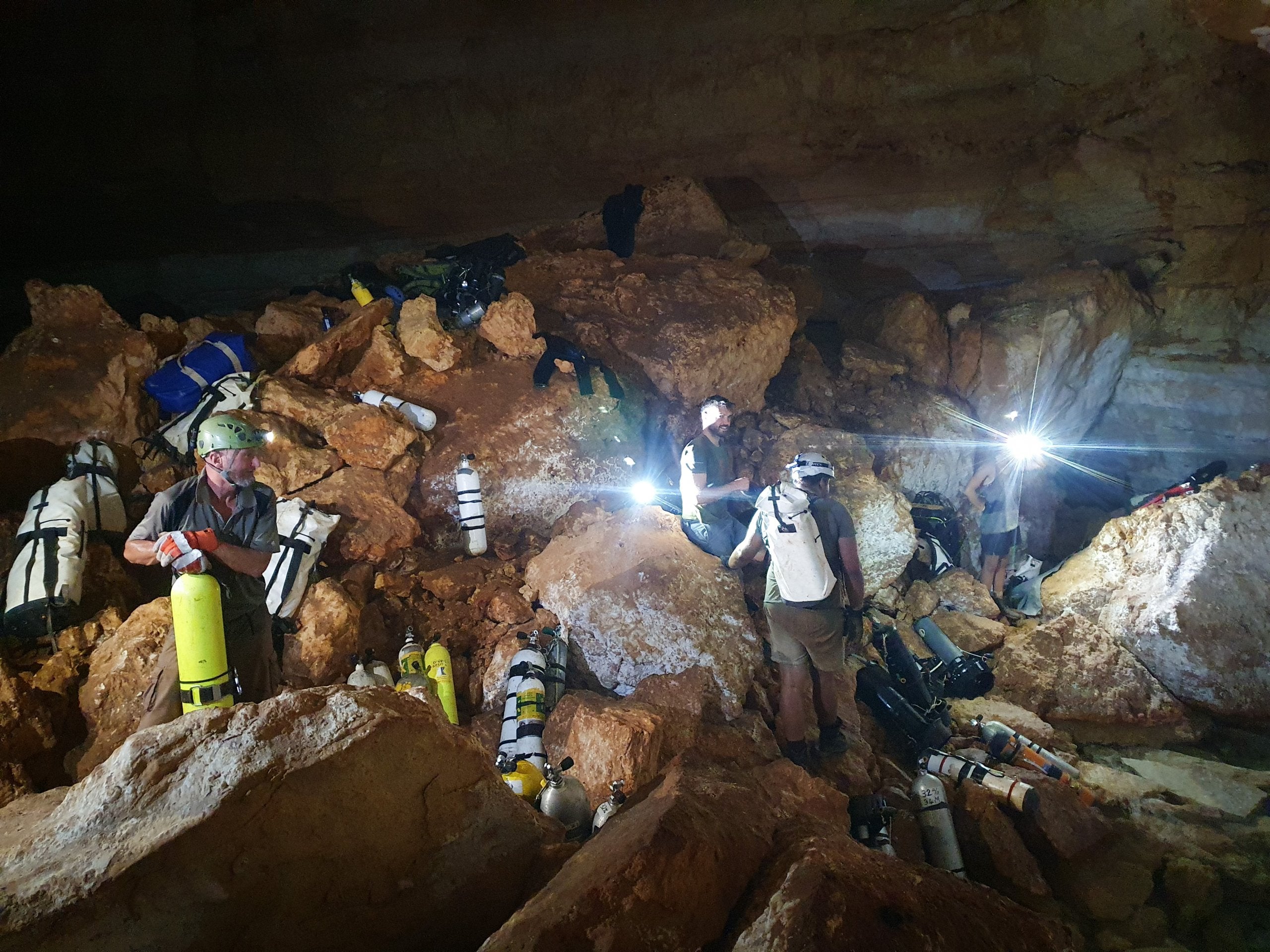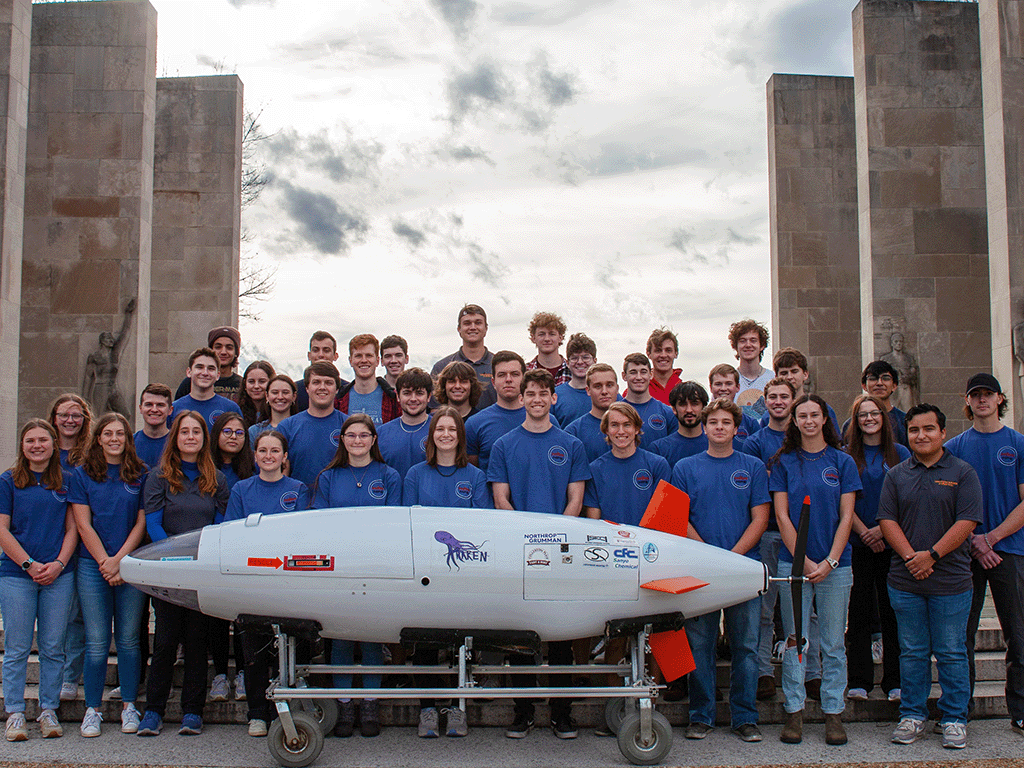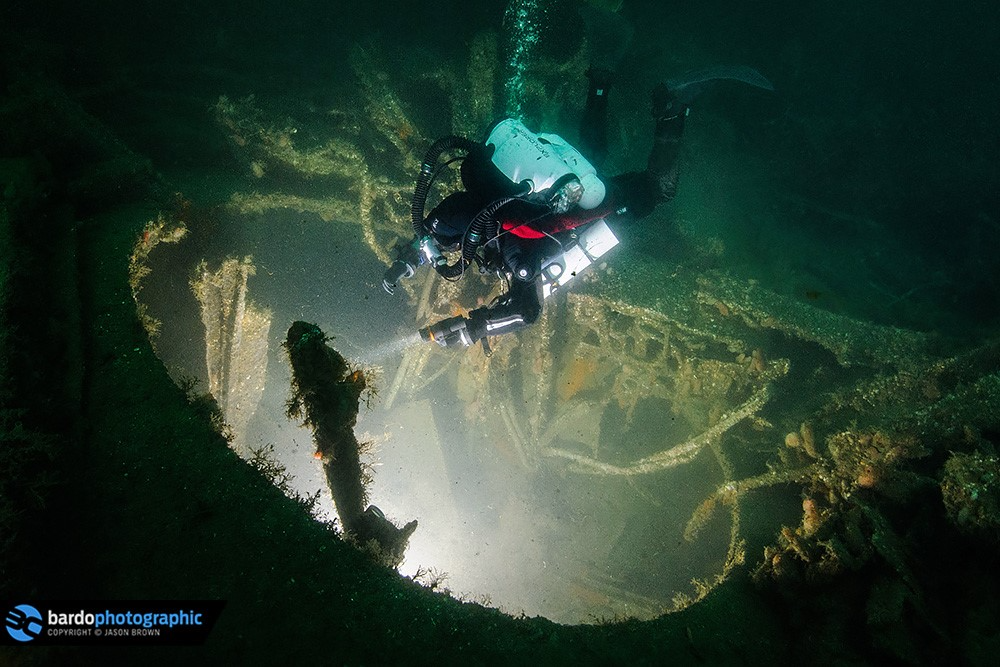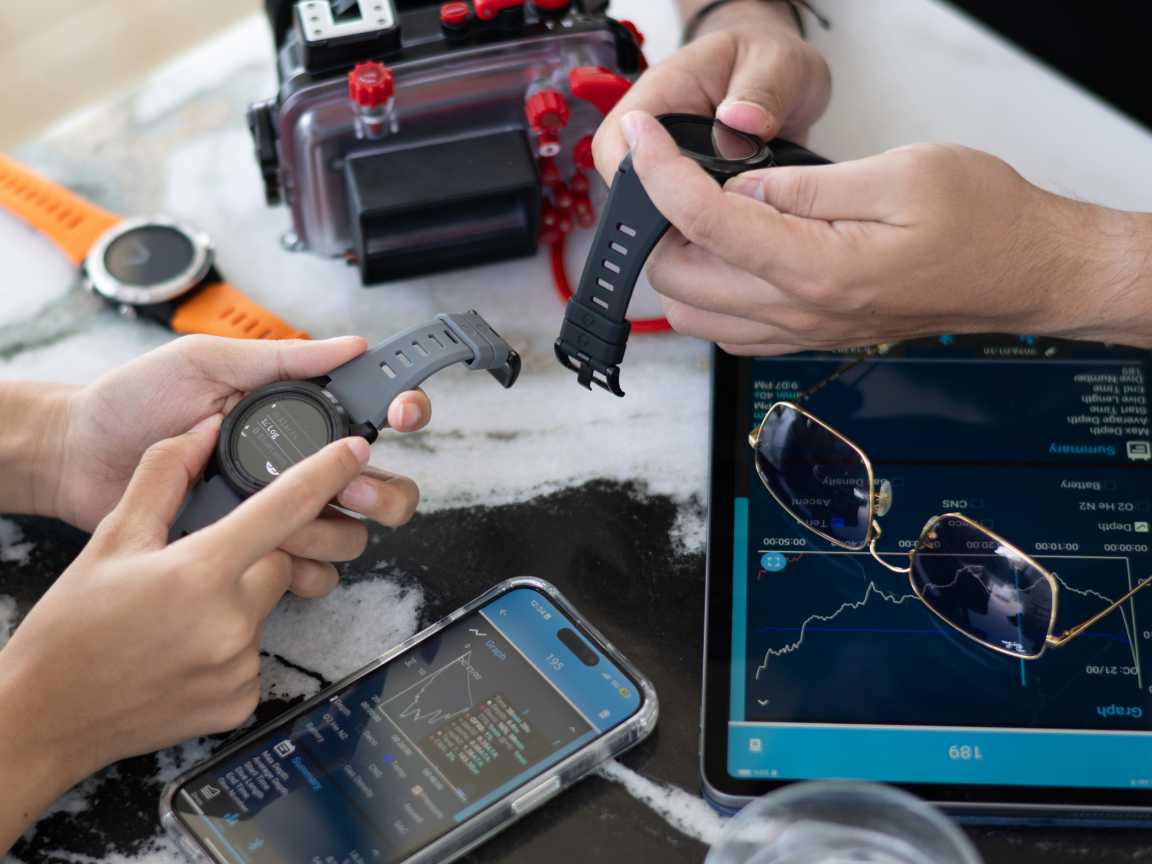In April 2023 I was fortunate to join an expedition to dive in a cave that people rarely dive in Western Australia. This place is in the Nullarbor Plain, part of a large desert. Even for Australia, it is far, far, from anywhere. People rarely dive in Pannikin Plains, partly because of the effort required to access the water, and partly because it was only reopened for diving, for adequately experienced and qualified cave divers, in 2018. The goal of the expedition was to continue exploration in the hopes of finding another giant, on-going cave tunnel. Finding another mega tunnel in the area would be like finding the holy grail (our trip theme song, and the expedition team are all Monty Python fans). This was my first trip to dive the Nullabor caves, and what an amazing experience it was!

The team, and gear - Stew, Andrea, Aimee, Chris, Bruce, Skanda, Ryan, and Steve.
The Exploration History of Pannikin Plains
Pannikin Plains Cave on the Nullabor plain has a long, interesting exploration history. Like many of the high plains caves, exploration was begun by divers in the 1970s. Famously, during an expedition in 1988 led by Andrew Wight (of Hollywood film Sanctum fame) that included many leading cave divers including Wes Skiles, an extreme storm resulted in rainwater flooding into the cave, causing some of the dry section to collapse. This trapped fifteen expedition members inside and it was a few days before the rubble was cleared so they could get out. Luckily no one was seriously injured.
It was amazing to see what these pioneers were able to achieve with the equipment of that time, pushing beyond the massive dry chamber called Concord Landing, one kilometer away from the surface! This expedition, including the flooding, was captured on film and became a documentary called "Nullabor Dreaming", and also became the idea behind the film Sanctum. Because of the collapse and the unstable rocks that threatened further collapse, the cave was deemed unsafe for diving and access was closed for everyone.
More recently, teams of divers with the appropriate skills and scientific research interests were able to get permits to dive. Teams led by Tim Payne, Chris Brown, and Dave Fielder continued the exploration in the cave, as well as producing a cartographic map. In a 2016 expedition, Ryan Kaczkowski was pushing lines at the end of the second sump and squeezing through a series of restrictions, and discovered a surface lake he was able to climb out of and into a new air chamber. It’s not easy to get there!
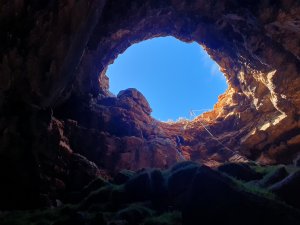
The entrance looking up from the bottom of the zip line.
Climbing up a vertical chimney and squeezing under a fallen boulder, you emerge at the bottom of a steep pyramid shaped hill. Ryan named the chamber Chapel Hill, and scouted the other side for water. He found a very small surface lake, and managed a dive in sump three (sumps are the water filled sections of dry cave) into a small room ending in a restriction. In their 2017 expedition, Stephen Fordyce, Stefan Eberhard, and Ryan pushed through a restriction from a surface lake in sump three to find more going passages on the other side. But due to other projects and the Covid pandemic, plans to return were never realized until 2023. The plan for our expedition was to push sump three and hopefully break out into power cave, the holy grail for exploration.

Climbing down through the dry section.
Expedition Diving
The caves of the Nullabor are remote and real expedition diving. With the closest major city Perth, a twelve hour drive away, everything needs to be brought in with you. Between the eight expedition members we had a huge amount of personal dive gear, many tanks, 3 large cylinders of oxygen, camping gear, 2 compressors, 2 generators, various camp fridges, 11 Diver Propulsion Vehicles (DPVs), various ropes and rigging equipment, 2 ladders, and more than enough food, fuel and water for two weeks camping. Pannikin is close enough to the Cocklebiddy Roadhouse, where pub meals, drinking water, shower and laundry facilities and fuel are available (for a taste of civilization).

I had my Australia trip planned already for March/April 2023 and when I told Stephen Fordyce (an old dive buddy and keen explorer) about my dates, he said he had something going on around the same time that might interest me. I was lucky enough to be invited to join the expedition when the last of the eight places on the permit opened up with dates that matched my trip! I joined seven other divers - Stephen, Chris and Aimee from Victoria, Ryan, Andrea and Stewart from South Australia, and Bruce from New Zealand.
As the international team, Bruce and I met in Perth and drove across Western Australia to Cocklebiddy, while the other team members drove from the east. When I landed in Perth, Bruce was waiting for me at the airport with his rental van/camper van. We made a quick supermarket stop for fresh fruit and vegetables (border controls don’t allow fresh produce from the eastern states into Western Australia), and hit the road. We drove a solid section of the way, before stopping for a sleep in a small town’s motel and continuing on the next day. On the way, we got the classic Nullabor tourist photo with the straightest road sign! Arriving at the camp site we met the team, unloaded, I pitched my tent, and we began to prepare gear to get it into the cave.

The Nullabor's famous road sign.
Setting up the cave for diving
The set up to get gear into the cave to begin diving was definitely much more work than I am used to! The caves openings on the high plains are ninety meters above the water level, and are huge collapses sloping gradually down. For Pannikin, the team was able to set up a fifty-meter flying fox (zipline) to send tanks, DPVs, and caving bags of gear down. At the bottom of the flying fox, gear was carried down to a pitch where it could be lowered down twenty meters on ropes to the ‘plughole’, a small restriction before the cave opens up into a long room with the surface lake at the far end. From the bottom of the ‘plughole’ all the gear was carried down the rock collapse before hiking it to the lake. It took the eight of us a day and a half before all the gear was at the water!

Our dressing area at the beginning of the first sump.
With gear at the water’s edge, Bruce and I were keen to get in a dive to see the cave immediately! We wanted to start to familiarize ourselves with the cave’s navigation, check gear was working as it should after travel, and weights for the brackish water and tanks we were using. We geared up at the water's edge, ran through our predive checks, collected additional bailout tanks to stage in the cave, and descended.

Skanda loaded up with tanks, drytubes, and scooters to stage in the cave.
The cave itself is not only impressively big but really, really cool looking! Massive power tunnel begins as soon as you drop down from the surface lake, with a ceiling depth of around 20 meters and the floor closer to 40 meters. The water is crystal clear with blue tinges, and visibility as far as your lights can reach. The cave also has some side passages, generally a lot smaller and interesting to dive. The tunnel continues for nearly a kilometer before starting to shallow up to a series of collapses and surface lakes before ending in ‘Concord Landing’ - a massive dry chamber containing two rock piles separated by a long lake. The cave continues on the other side of the second rock pile.

Impressive sized tunnels.
Exploration of new cave
The main goal of the expedition was to continue the exploration of sump three. When looking at the survey data of sump three compared to the rest of the cave, Steve had determined that where they had explored was more likely offshoot passages, rather than the continuation of the mega tunnel. So dives in sump three were planned to try to push the cave and break into the main tunnel. This was the holy grail we were searching for, a break into a massive tunnel would be a significant breakthrough as no new major tunnel on the high plains had been discovered in decades.

Skanda ready to depart.
Over our ten days of diving, we put pairs of divers into sump three to continue the exploration. Each of the push divers all used KISS rebreathers for the more than two kilometer journey to sump three (one Sidewinder, three Sidekicks) before climbing over Chapel Hill and diving open circuit in sump three. Steve did the most pushing there. Wriggling through small silty tunnels to find a few hundred meters more cave. Conditions on the other side of Chapel Hill were generally pretty small, with silty passages, without many options to make solid tie-offs. Silt pegs were used to secure the line. On my dive in the third sump the visibility was still pretty milky from the previous days’ dive efforts in there, further making progress difficult.
While most of the focus of the exploration was on sump three, the rest of the cave has many branching side tunnels that have been explored but could be pushed. I spent some dives in the first sump surveying some lines that were missing from Tim Payne’s map. Having surveyed these lines, I noticed that there were some potential places where it looked like the cave continued after the end of the line. I connected my reel into the end of the line and continued to explore the cave through a low tunnel that zig-zagged until ending in a pretty small restriction. Being at the end of a longer dive, I listened to my more cautious inner voice, cut the line and surveyed out. When plotting the survey, the line I had laid seemed to be extending out, away from other lines and going towards a blank space on the map. Suddenly, the dark space on the other side of the restriction looked more interesting!

Stewart and Andrea.
On our last diving day, I returned to my end of line to push through the restriction and continue on. It took me a bit of time to remove my tanks and find the best orientation to squeeze through but I managed. On the other side, as the visibility cleared up, the cave continued to open up into smallish tunnels that seemed to intersect with breakdown collapses. I kept exploring, and with each corner I turned expecting the cave to end, but it continued. While I still had line on the reel, I was getting close to my bailout range (distance into the cave I can travel with the open circuit gas I was carrying). Turning one more corner, I cut and tied off the reel and began to survey out.
Once again I was very happy to have my MNemo survey tool. The cave was silty, and being an average of twenty-two meters deep in this section meant that I had accumulated some deco already on the way in. Having a more efficient means of survey on the way home was appreciated as it meant less time spent working at depth.

Skanda recieving a tank on the flying fox.
As this was our final day of diving, we also had to bring all of our tanks and other equipment out of the cave. And then spent a day hauling, winching and portaging gear out of the cave. Thanks to the rigging and perseverance of Steve and Stew a functional system was set up where two tanks (or DPVs, caving bags) could be connected to ropes and pulled up the pitch and the flying fox at the same time. This was accomplished by signals being passed up from the bottom of the pitch via radio to teams at the top of the pitch and bottom of the flying fox, who then called up to Stew. Stew, at the top of the flying fox, in turn lowered a flag which was the signal for Andrea in her truck to drive slowly away - winching up the rope and the connected items. With this elaborate system in place, we were able to haul out all of the gear in one day.

The pully system for the haul out, and Stew's signal flag.
We didn’t find our holy grail on this expedition. Is it there? Where is the continuation of the massive cave tunnels? These are questions that hopefully future expeditions will be able to answer. But for this trip, all divers had a great time, and for the majority of the team it was our first time diving Pannikin. Which in itself was cool and the desert camping experience was special. We did manage to add some more new cave to the total size and distance of the cave. And of course we now know what to expect for future expeditions and where to push our exploration efforts.
With a rest year planned for 2024 (to allow time to soften the memory of the effort required to get gear in and out of cave) we will have to wait for 2025 to see how future exploration unfolds.
Photos courtesy of Skanda Coffield, Stephen Fordyce, Ryan Kaczkowski, and Bruce Clulow.
---

Written by Skanda Coffield
Skanda Coffield-Feith is a cave and rebreather diving instructor, and cave explorer. He is based in Tulum, Mexico; ten minutes drive from the worlds longest underwater cave systems. Originally from Melbourne, Australia, he learned to dive in Koh Tao, Thailand in 2006 and was immediately hooked. He spent some years diving some of the best locations around South East Asia as a recreational diver, before discovering that he could dive in Melbourne. Diving in Melbourne he was introduced to technical diving and heard about cave diving. During a trip to Mount Gambier, he was introduced to the famous Australian caves and became a cave diver. Skanda now spends most of his time teaching at ProTec Dive Centers Tulum. Focusing on training divers in cave diving specialty courses like cave survey and stage cave, as well as teaching the KISS Sidewinder Closed Circuit Rebreather. When he is not teaching, he is out in the jungle exploring new cave systems. He has been involved in some remarkable exploration projects in Mexico, and is always looking for the next project!
Bio photo courtesy of Alvaro Herero / Mekan Photography.

